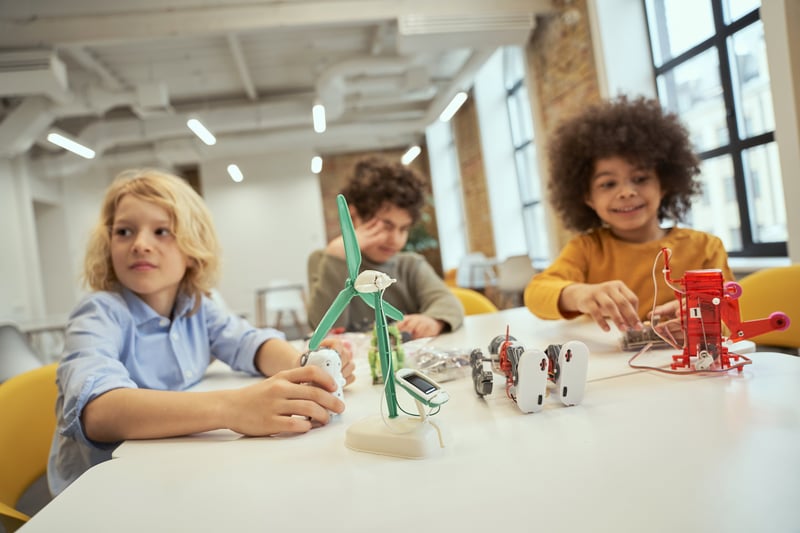Get Healthy!

- Amy Norton
- Posted September 6, 2023
Boosting Their Creativity Helps Kids Face Life's Challenges, Study Finds
Just like adults, kids face daily stressors.
Luckily, a new study suggests that teaching them creative thinking can help them manage it all.
Researchers found that when school-age children learned some "narrative creativity" techniques -- such as shifting your perspective and imagining "what if" scenarios -- they quickly became better problem-solvers.
After a week-long creativity camp, or even just a single lesson, kids showed more confidence in their ability to face life's daily problems and come up with a "plan B" when necessary.
The study was small, based on 60 kids attending the same summer camp. But experts said the findings just make sense.
When kids can think flexibly, they are less likely to "panic" in the face of challenge, said study author Angus Fletcher, a professor at Ohio State University.
Instead of simply giving up, he said, they are more apt to hunt for alternative solutions -- a capacity called resilience.
"Kids have some of the same daily challenges that adults do," Fletcher said. "Their biggest problems aren't in math, they're in interacting with other kids."
Yet, Fletcher noted, schools typically focus on test scores rather than life skills.
Meanwhile, parents, however well-intentioned, can also get in the way -- if they rush to fix their child's dilemma or tell them the "correct" solution.
"It's very challenging for some parents to resist that," Fletcher said. "But you should try to create an environment where you allow your children to do it their way."
"The world your child is facing is different from the one you did growing up," he added. "You need to teach them to be problem-solvers, rather than program them with the 'correct' answers."
The findings, published recently in the Journal of Creativity, come from two small studies, each of children at a summer camp in Ohio. All were in third through fifth grade.
In one study, the researchers divided 32 kids into two groups. One had a crash course in narrative creativity, while the other served as a comparison group. Kids in the creativity group were asked to think of someone in their lives with a special skill and consider that person their "creative friend" who could give advice when they're in a scrape.
That tactic, Fletcher said, is known as perspective switching -- the ability to look at a problem through someone else's eyes.
Next came the "problem" challenge. Kids in both groups were asked to think of a problem in their own lives; some responses included "my dad has to be away for two months" and "my sister bullies me." They were also given a hypothetical problem to ponder (being unable to attend a friend's birthday party, for example).
All of the children were tasked with devising possible solutions to those dilemmas; those in creativity group were specifically told to imagine the advice their friend might give.
In the end, Fletcher's team found, nearly all of the children in the creativity group were able to conjure up potential solutions. In contrast, most kids in the comparison group were not: Fewer than half came up with answers to the hypothetical problem -- and not one had a solution to their own real-life challenge.
In the second study, involving another 28 kids, the researchers tested a 10-hour creativity training program spaced out over five days. Besides perspective-switching, the training taught kids to come up with "what if" scenarios and, when frustrated by a task, to take a step back and think about their broader goals.
The results were similar to those seen in the first study: After the training, every child was able to come up with not one, but two, plans to attack both hypothetical and real-life problems.
Anand Patel is a child psychologist at Montefiore Medical Center in New York City. He said the findings resonated with him because he uses similar tactics with children who have anxiety or depression.
Those kids, Patel said, are essentially in a "stuck" way of thinking, and the goal is to get them "unstuck."
"I try to help kids take on a different perspective," Patel said. That, he added, could mean asking them to step outside of themselves and think, "What if this were my friend feeling this way? How would I help them?"
What's interesting about this study, Patel said, is that it focused on healthy kids in their everyday lives.
It's true that old-fashioned free play gives room for creative thinking. But the reality is, kids today are fixated on devices rather than face-to-face interactions, both Fletcher and Patel said.
And play time on devices, Fletcher noted, is different from the old-school kind.
"Kids are getting really good at these digital tasks," he said. "But that's much simpler than real life."
So, it's more important than ever to help kids develop the creative thinking they need to navigate life, both experts said.
It's not, however, only children who can learn to think more creatively. The course kids took in this study, Fletcher said, was similar to one his team has used for resilience-building among U.S. Army Special Forces units.
More information
The American Academy of Pediatrics has more on screen-free activities for kids.
SOURCES: Angus Fletcher, PhD, professor, English, Ohio State University, Columbus; Anand Patel, PsyD, child psychologist, Pediatric Behavioral Health Integration Program, Montefiore Medical Center, New York City; Journal of Creativity, Aug. 4, 2023, online
